AIMS AND OBJECTIVES OF PRACTICING KUNGFU
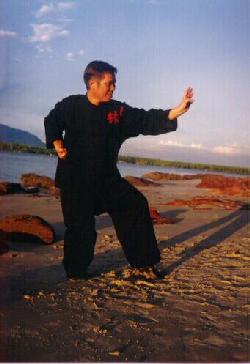
Sifu Wong in a Shaolin kungfu pattern called “Single Tiger Emerges from Cave”
Find out what you need to know about aims and objectives before you begin your Shaolin Kungfu or Taijiquan training
Why do You Practise Kungfu?
One important reason why the standard of kungfu today is generally low is that many people practice kungfu without being aware of their aims and objectives.
If you ask someone who has practiced kungfu for many years why he has done so, it is not uncommon for him to have difficulty finding the real answers.
He may say he practices kungfu for self-defence, for health or for keeping alive a worthy tradition, but on deeper examination he often finds that those are not the real reasons.
This is evident from the fact that despite many years' training, he cannot defend himself with the kungfu he has learnt, is not as healthy and fit as a typical kungfu exponent recorded in classical kungfu literature, and knows little about kungfu tradition.
The truth is that he has practiced kungfu without any clear set aims and objectives.
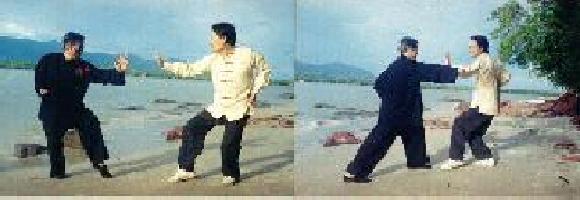
Making Your Training More Rewarding
Obviously, if we are clear about our aims and objectives, our training will be more rewarding. Not only we shall not waste time over unnecessary training, we shall also have a higher level of attainment.
For our purpose here, aims refer to general and long term aspirations, and objectives to measurable and more immediate needs.
There are three aims in all kungfu training:
- Combat efficiency.
- Health and fitness.
- Character development.
For great kungfu like Shaolin Kungfu and Taijiquan, there are two further aims:
- Mind expansion.
- Spiritual cultivation.
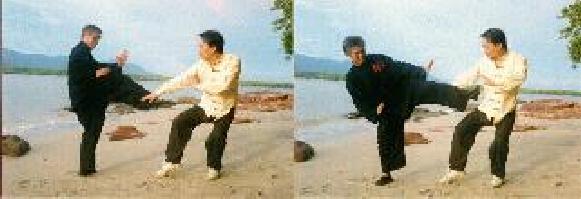
Self Defence, Health and Fitness
Combat efficiency is the first and foremost aim of all kungfu training. The term kungfu, especially as used in the West, means martial art.
It is ironical, therefore, if you practice kungfu (including taijiquan) but do not know how to defend yourself with what you have learnt.
The second aim of kungfu training is health and fitness. Indeed, in our modern societies where fighting seldom happens, this benefit of being healthy and fit is more immediate and important than being able to fight.
But the crucial point is that you will derive the radiant health a typical kungfu exponent of classical kungfu literature manifests, only if you practice kungfu as a martial art. If you practice kungfu dance, you will only get the type of health benefit that a dance can give.
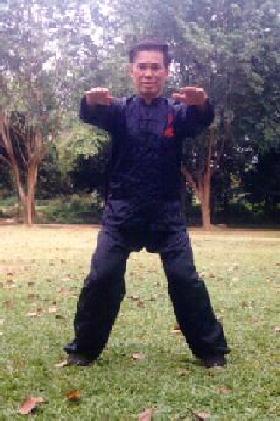
Character Development and Spiritual Cultivation
Kungfu training itself is a process of character development.
Qualities like tolerance, endurance and perseverance are developed if you practice kungfu the way past masters did, such as practicing “Golden Bridge”, “Small Universe” or “Lifting Water” everyday for years. Qualities like mental freshness and calmness are pre-requisite if you wish to be a good kungfu fighter.
Great kungfu like Shaolin Kungfu and Taijiquan is more than a mere fighting art. Both Shaolin Kungfu and Taijiquan expand the mind and leads ultimately to spiritual fulfillment.
Meditation, known as chan (zen) in Shaolin Kungfu and jing-zhou (silent-sitting) in Taijiquan, is an essential aspect in all levels of these two arts, although it is emphasized at the advanced levels, and although not many people today may be aware of this fact. Actually, the original aim of Bodhidharma and of Zhang San Feng, the First Patriarch of Shaolin Kungfu and Taijiquan respectively, when they first initiated the arts, was spiritual cultivation.
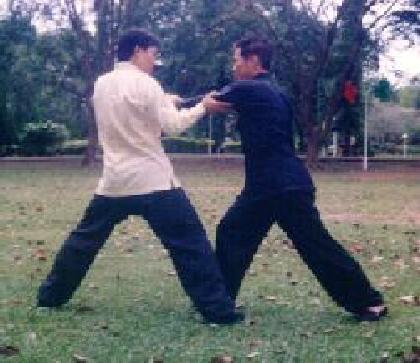
Setting Measurable Objectives
Besides being clear of our general aims and consciously strive to achieve them, it is helpful to set measurable objectives for more immediate needs.
In order to attain the general aim of combat efficiency, we may set objectives like developing powerful arms and agile footwork, and mastering defence techniques against common attacks.
We may, for example, set aside one year to practise how to counter the various kicking attacks typically executed by Taekwondo and Siamese Boxing exponents.
To attain good health and fitness, we may train the Shaolin art of "One-Finger Shooting Zen" or the Taijiquan art of "Three-Circle Stance" everyday for six months as our set objectives.
After the six month period we can assess whether we have been successful in meeting our objectives by using measurable tests like checking whether we are now comparatively free from cold and fever which we used to have, and whether we can comfortably block our seniors' attacks in sparring practice when previously we could do so only with difficulty.

Enriching our Lives
Setting objectives like increasing our endurance and perseverance levels from a minute to five minutes over a period of six months in zhang-zhuang (stance-standing) training can be readily combined with the objectives of developing internal force.
It will be useful to check whether we have also transferred these qualities to our daily life, such as examining ourselves to see whether our disciplined kungfu training has made us more tolerable to other people and more capable of facing demanding tasks.
The various meditation methods in Shaolin Kungfu and Taijiquan enhances our mind and spirit. In eastern philosophy the mind and spirit are often regarded as one. We may, for instance, set objectives like enhancing our mental clarity so that we can comprehend a problem in five minutes when it took half an hour in the past.
Hence, if we are clear about what we intend to achieve in our kungfu training by setting aims and objectives, we can not only get more benefits from our practice in shorter time, but also enrich our as well as other people's lives.
